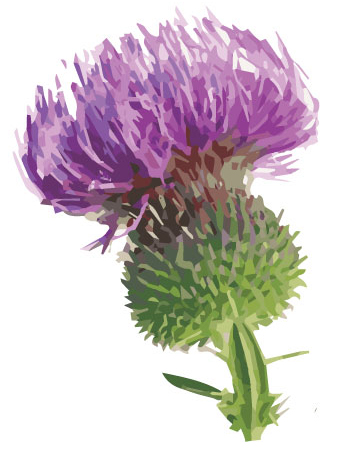Research on the effect of milk thistle in food on our immune system
Milk thistle (Silybum marianum)
valued since pre-Christian times
Milk thistle has been used for over 2000 years as a remedy for liver cirrhosis, hepatitis, jaundice, kidney and urinary stones, snake bites, irregular menstruation and spleen problems.[1] In the centuries-old healing tradition of monasteries, milk thistle is recommended not only for liver diseases, but also for gallbladder, stomach, lungs and for women's diseases.[2] In traditional Chinese medicine, milk thistle is used to stimulate the production of bile and protect the liver.[3]
Research confirms that milk thistle
improves liver function by supporting detoxification and regenerating damaged liver cells, significantly reduces symptoms and complications in patients with type 2 diabetes, and lowers blood sugar and insulin levels.[4] [5] Is used against poisoning by tuberous-leaf mushrooms and fly agarics,[6] [7] inhibits the growth of tumor and cancer cells in breast, ovarian, prostate, and bladder cancers,[8] and increases the effectiveness of chemotherapeutic agents.[9] relieves chronic stress through strengthened growth of nerves and neurites.[10] strengthens the immune system through increased production of lymphocytes and endogenous messengers.[11]
Caution
Preparations with milk thistle must be avoided in case of allergies to daisy plants because of possible cross-allergy. [12]
[1] Ludovico Abenavoli, Raffaele Capasso, Natasa Milic, Francesco Capasso. Milk thistle in liver diseases: past, present, future. Phytotherapy Research, Wiley, 2010, 24 (10), pp.1423.10.1002/ptr.3207. hal-00599834
[Archive ouverte HAL]
[2] Ašic, Simon, Pater Simons Hausapotheke: Handbuch zum Bestimmen und Sammeln von Heilpflanzen mit ausführlichen Rezepten, 2000
[Amazon]
[3] Murphy, J. M., Caban, M., & Kemper, K. J. (2000). Milk thistle (Silybum marianum). Longwood Herbal Task Force.
[ResearchGate]
[4] Velussi, M., Cernigoi, A. M., Dapas, F., Caffau, C., & Zilli, M. (1997). Long-term (23 months) treatment with an anti-oxidant drug (silymarin) is effective on hyperinsulinemia, exogenous insulin need and malondialdehyde levels in cirrhotic diabetic patients. Journal of hepatology, 26(4), 871-879.
[ResearchGate]
[5] Velussi, M., Cernigoi, A. M., Viezzoli, L., Dapas, F., Caffau, C., & Zilli, M. (1993). Silymarin reduces hyperinsulinemia, malondialdehyde levels, and daily insulin need in cirrhotic diabetic patients. Current Therapeutic Research, 53(5), 533-545.
[Science Direct]
[Europe PMC]
[8] Ramasamy, K., & Agarwal, R. (2008). Multitargeted therapy of cancer by silymarin. Cancer letters, 269(2), 352–362.
[Science Direct]
[9] Agarwal, R., Agarwal, C., Ichikawa, H., Singh, R. P., & Aggarwal, B. B. (2006). Anticancer potential of silymarin: from bench to bedside. Anticancer research, 26(6B), 4457-4498.
[Anticancer Research]
[10] Kittur, S., Wilasrusmee, S., Pedersen, W. A., Mattson, M. P., Straube-West, K., Wilasrusmee, C., ... & Kittur, D. S. (2002). Neurotrophic and neuroprotective effects of milk thistle (Silybum marianum) on neurons in culture. Journal of Molecular Neuroscience, 18(3), 265-269.
[Springer-Verlag Berlin Heidelberg]
[11] Wilasrusmee C, Kittur S, Shah G, et al. Immunostimulatory effect of Silybum Marianum (milk thistle) extract. Med Sci Monit. 2002;8(11):BR439-BR443.
[PubMed]
[12] Mariendistel – Hinweis
[Arzneipflanzenlexikon]

 Deutsch
Deutsch 